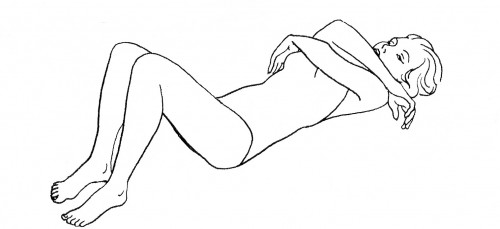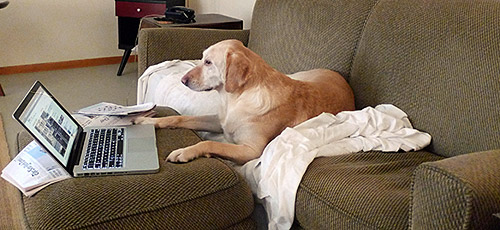
I love a well-stocked pantry. It makes me feel safe. I'm not talking levels that might lead to participating in a reality show - just the basics, but with a definite flair. When I'm grocery shopping, I buy things that complement my foundation at home. A yoga practice should serve the same purpose. We practice when we're feeling calm. Then when we get anxious, agitated, or uncomfortable, we do a couple of specific things that we know will adress our current state. Because we've stocked our yoga pantry, we can efficiently bring ourselves back from the brink.
Constructive Rest Position is the equivalent of that can of tuna or black beans that are pantry must-haves.
I first learned Constructive Rest Position as a curious 25 year old dance student in New York City from Nancy Topf. She learned it from Barbara Clark, who was a student of Mabel Todd, author of "The Thinking Body" (1937). This pose is a body tonic. Lying on the floor with knees bent and feet hip distance apart, brings rest without collapsing (think opposite of curling up on the couch and getting up feeling stiff and worse than when you laid down) The floor provides a solid support and our bodies respond in kind. Place your feet in a way that relaxes the legs and hips as much as possible. Arms can be crossed over the chest or resting along your sides. If you remain in the pose for several minutes, the deep muscles connecting the legs to the back (psoas) will release and lengthen. This can effectively address whatever ails you structurally; low back pain, hip & knee pain, even neck issues, as the spine is brought into a supported neutral position.
The Mind-Body Connection:
Practice Constructive Rest Position when you want to cultivate a quality of quiet alertness. If you feel you're being pulled in all directions, it will help you to get grounded, settle back into yourself, and connect to the simplicity of body and breath.
The image above is from Dr Lulu Sweigard's book "Human Movement Potential." Learn more about this lineage of somatic innovators - some born in the late 1800s.
Heat advisory
Midwestern day in July
Tap your inner sloth

While browsing at Half Price Books I began paging through "The Secrets of People who Never get Sick" by Gene Stone. I had my smirk on. Really? They never get sick? Is that even a good thing? Then I saw the chapter extolling the health benefits of napping and paid the half price. (Napping? Basically it's a very good thing) Apparently, in days of yore we were polyphasic sleepers - sleeping in multiple short periods over a 24 hour stretch. This was necessary due to a semi nomadic lifestyle. Then, biphasic sleeping was all the rage - sleeping for one long period during the night and one short period during the middle of the day. We can trace a basic human disdain for being awake at midday to this evolutionary memory. More importantly, if we're asleep at noon, we avoid the wrath of Poludnica aka Pscipolnitsa - a noon demon in Slavic mythology. In English she's Lady Midday.
According to Eastern European lore, if this mythical spirit catches you out in the fields on a hot summer day she will give you heatstroke, aches in the neck, cause you to go mad, or lop off your head with a scythe. She may appear as a whirling dust cloud, and is the personification of a sun-stroke. In ancient Rome the noon nap was an institution known as the hora sexta - the sixth hour past dawn. Then came the mechanical clock, and the hourly wage, and off to hell in a handbasket we've gone. But I know one cool gal who won't be losing her head...
The puddles abound
And make for a soggy hound
Go through or around?
The tendency to make things more complicated than they need to be prevents us from starting or developing a healthy habit. Simplicity should be invited in, like an old friend.
My radical proposition is this: Take a walk.
Adapted from Spontaneous Healing by Andrew Weil:
“Human beings are meant to walk. Our bodies are designed for locomotion. Walking is a complex behavior that requires functional integration of many sensory and motor experiences; it exercises our brains as well as our bodies.
When you walk, the movement of your limbs is cross-patterned; arms and legs move in opposition to each other. This type of movement generates electrical activity in the brain that has a harmonizing influence on the whole central nervous system-a special benefit that you do not necessarily get from other kinds of exercise. In my opinion, walking is the most healthful form of physical activity, having the greatest capacity to keep the healing system in good working order and increase the likelihood of spontaneous healing in cases of illness.”
You do not have to learn how to do it. No special equipment is required, other than comfortable shoes. It costs nothing, and the chance of injury is small. If you have one of these, coax her off the couch and get going…

